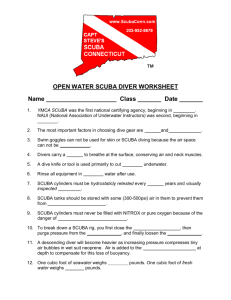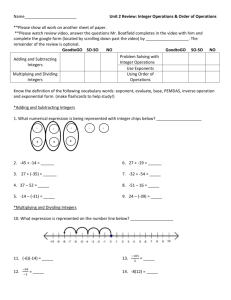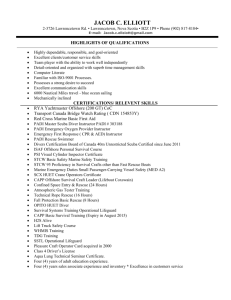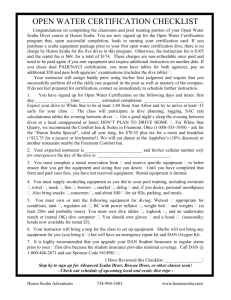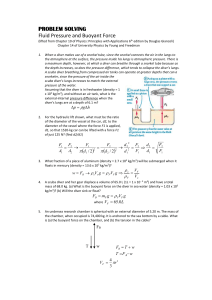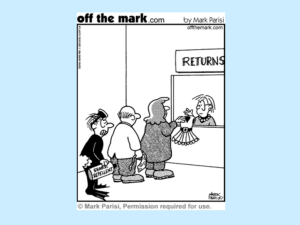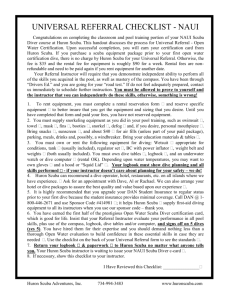Introducing OUC Sport Safety
advertisement
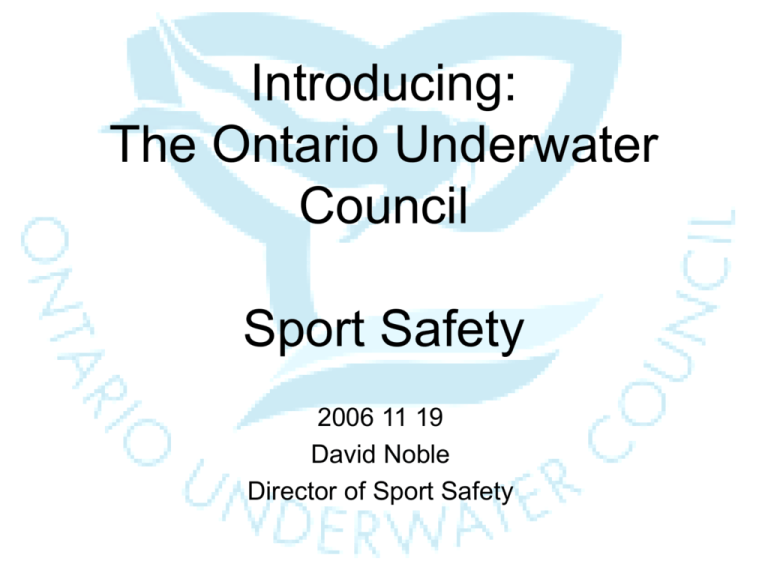
Introducing: The Ontario Underwater Council Sport Safety 2006 11 19 David Noble Director of Sport Safety What is Sport Safety?? Doing things which help to make divers more conscious of issues which could affect their lives. 5 How does the OUC contribute to Scuba Diver Safety? • • • We own and operate one of Canada’s longest-established compressed air testing operations, known as the Canadian Air Purity Inspection Program – Providing a service to Scuba Retailers, Clubs, and Charter Operators that own and operate air fill stations. We test their compressed air samples to CSA’s Z180.1-00 Standard, – Providing clean and safe air supplies for Ontario divers We work with provincial agencies – to promote awareness of the scuba flag within the boating community (Aviva Barth Memorial Project) – OUC Vessel Inspection Program, to ensure new wrecks / artificial reefs are safe for the environment and divers. We develop and implement Scuba Diver Safety Awareness Programs – (e.g. Fathom Five) Continued… 6 How does the OUC contribute to Scuba Diver Safety? (cont’d) • Hyperbaric Facilities – We are working with all stakeholders to keep and expand hyperbaric facilities for Divers (and others) in the province. • Dive Incident Notification – We are the only Provincial Scuba Organization in Canada that publishes an Online Scuba Incident Report within 72 hours of notification, containing: • A summary of the incident (near miss and/or fatality) • Any relevant information from respected Public-Domain sources • Any relevant recommendations to prevent recurrence 7 OUC Safety Initiatives Aviva Barth Memorial Project • Boater / Dive Flag Awareness Program Parks Canada (Federal Government) • Fathom Five - Scuba Diver Safety Awareness Program Transport Canada • “Transport of Dangerous Goods Act” Town of Goderich (Municipal Government) • “The Maitland Star” 8 Aviva Barth Memorial Project Who: • Aviva Barth, a 30 year old, student diver When: • August 7, 2004 at approximately 17:45 hours Where: • the government dock at Big Bay Point on Kempenfelt Bay (Lake Simcoe). 9 Aviva Barth Memorial Project The Incident: • Aviva Barth was killed instantly when struck by a 25-foot-long power boat travelling at a high rate of speed. • She was just coming up with her diving partner in approximately 10’ depth of water between a dive flag and the government dock. • Police say the boaters may not be aware that they hit anything • Postings about the incident on diving message boards on the Internet suggest many boaters routinely ignore dive markers, red flags with a diagonal white stripe that are hoisted on buoys to indicate divers are in the water below. • boaters are often not familiar with, or are dismissive of dive markers. 10 Aviva Barth Memorial Project Why: • Due to the deaths of SCUBA divers, snorkellers and swimmers in recent years, the OUC sees an immediate need to make boaters more aware of other users of the water. • The OUC’s initiative is to make boaters aware of the use of dive flags, what they mean and how they should be treated. 11 Aviva Barth Memorial Project The OUC will promote awareness of the scuba flag within the boating community • Signage will be developed and posted at all boat launch ramps in Ontario • Flyers will be produced$ and floating key fobs will be handed out to boaters on the water, and at trade shows • Articles will be published in Boating Magazines • Posters will be posted at marinas and boating clubs • Guest speakers will be offer to present to boating organizations • Video presentations will be produced which can be used in booths at boating trade shows, the Sportsman’s Show, the Extreme Adventure Show, etc. 12 Aviva Barth Memorial Project Resources: • Ontario Trillium Foundation (Grants) • Transport Canada – Boating Safety Office • Local OUC member clubs and OUC members • Dive Shops and Charter Operators • Steven Weir (publishing) • Ritchard Findlay (Video production) • Directors and Regional Co-ordinators • Boating trade shows, Sportsman’s Show, Extreme Adventure Show • Canadian Coast Guard • STOP program initiated by “Ontario Diving” members and Northern Tech Divers • Municipalities and other government agencies 13 Aviva Barth Memorial Project Boater / Dive Flag Awareness Program Diver Down Flag Alpha Flag 14 Aviva Barth Memorial Project Ontario / Canadian Regulations regarding the use of Dive Flags • In Canada there are NO regulations • The OUC will lead an initiative to have SCUBA flags recognized in Canada / Ontario • the rule of thumb is: • Vessels stay 100 feet away • Divers stay within 50 feet NOTE: • In the USA, individual states have unique regulations www.dive-flag.com 15 Aviva Barth Memorial Project Ontario / Canadian Regulations Extract from online boater safety course http://www.freecourse.ca/files/manual.pdf 16 Aviva Barth Memorial Project OUC Recommendations The use of Surface Marker Buoys should be considered mandatory in all areas where boating traffic exists. • Surface Marker Buoys should be highly visible and should prominently display the "Scuba Diver Down" flag, a bright red rectangular flag with a white diagonal stripe. • Ontario safe boating regulations require that boaters in the area "must take early & substantial action to stay well clear and pass at a slow speed". – – – "Prominent" is defined as: Easily visible from deck-height of a boat at least 100 metres/yards away The Surface Marker Buoy and vertical Flag/Symbol should extend at least 4' vertically out of the water. The Surface Marker Buoy and vertical Flag/Symbol should be easily visible from any direction of approach (360 degrees). This suggests that the vertical portion of the Surface Marker Buoy have 3 or 4 faces (in other words, have a triangular or square cross-section). 17 Aviva Barth Memorial Project OUC Recommendations – Surface Marker Buoys do NOT GUARANTEE that boat traffic will stay clear of your dive site. If you hear/see a boat approaching you at a high rate of speed, descend to a depth of at least 10' as quickly and safely as possible. Do not surface again until you hear that the boat traffic has safely passed. – Do not under any circumstances, tie or clip off the Surface Marker Buoy Line onto any part of your body or equipment. – Although present guidelines suggest that divers stay within 50' of their Surface Marker Buoy, the OUC recommends that when you are at the surface, you and your buddy stay within touching distance of your Surface Marker Buoy. 18 Scuba Diver Safety Awareness Program Fathom Five National Marine Park 19 Why Fathom Five needed a Scuba Diver Safety Awareness Program 2.00 1.50 1.00 0.50 2004 2003 2002 2001 2000 1999 1998 1997 1996 1995 1994 1993 1992 1991 1990 1989 1988 1987 1986 1985 1984 1983 1982 1981 1980 1979 1978 1977 1976 1975 1974 1973 0.00 1972 Scuba Diver Fatality rate per 2,000 Registrations Fathom Five Scuba Diver Fatality Rate per 2,000 Registrations, by Year Year After a 7-year track record of no fatalities between 1989 and 1995, the annual Scuba Diver Fatality Rate-per-2,000 registrations has started an unacceptable and accelerating upward trend. The goal of this SDSAP is to reverse this trend. 20 Scuba Diver Safety Awareness Program The 6 “building blocks” of Fathom Five’s SDSAP 1. A revised Scuba Diver Registration form 2. A revised Fathom Five “Diving Guide” brochure 3. A brand-new Fathom Five “Scuba Diver Safety Recommendations & Regulations” poster 4. A brand-new Fathom Five “Scuba Diver Fatality Charts” document 5. A brand-new Fathom Five “Scuba Diver Self-Evaluation Checklist” 6. A brand-new Fathom Five “Scuba Diving Sites” document All SDSAP deliverables feature a common “look & feel”, employ consistent language & terminology, and reinforce on one-another. 21 Scuba Diver Safety Awareness Program SDSAP deliverable #3: Brand-new “Safety Recommendations & Regulations poster AND handout” A poster-sized version of this document will be prominently displayed on a wall in the Diver Registration Office. An 8.5” x 11” version of this document will be handed out to every registering diver to keep. Registration Office staff will thoroughly review the contents of the document with every diver as part of the registration process. Please mouse-over to view. 22 Scuba Diver Safety Awareness Program SDSAP deliverable #4: Scuba Diver Fatality Charts This document will be made available by Registration Office staff to registering divers upon request only, and for viewing only. Please mouse-over to view. 23 Scuba Diver Safety Awareness Program SDSAP deliverable #5: Scuba Diver Self-Evaluation Checklist The proposal is to either post this in 8.5” x 11” format in the Diver Registration office, or to make it available to be handed out to Registering Divers. Mouse-over to view. 24 Scuba Diver Safety Awareness Program SDSAP deliverable #6: Fathom Five Scuba Sites The proposal is to post this document in 8.5” x 11” format in the Diver Registration office, and to make it available to be handed out (or sold*) to Registering Divers. (* ~$1 per copy if the GPS coordinates had an additional digit of accuracy). Mouse-over to view. 25 Transport Canada Transport of Dangerous Goods Act 26 Transport Canada Transport of Dangerous Goods Act • What are dangerous goods? – Tanks carrying compressed gases • How does this affect me? – Restricts amount of dangerous goods which can be carried in a road vehicle • What are the limits? – Much inaccurate info has been passed around 27 Transport Canada Transport of Dangerous Goods Act • Personal Exemptions – Maximum of 150 kgs (330 pounds) allowed – Maximum of 30 kgs (66 pounds) per tank – No special requirements except securing tanks • 500 kg Exemption – – – – – – Maximum of 30 kgs (66 pounds) per tank Requires signage on vehicle Tanks must each be marked Requires shipping documents and other documentation Does not require special training Restricts amount of dangerous goods which can be carried in a road vehicle 28 Transport Canada Transport of Dangerous Goods Act • Personal Exemptions – Based on manufacturers tank specifications • Luxfer Aluminum 80 cu ft = 11 tanks @ 14.3 kgs • Luxfer Aluminum 63 cu ft = 12 tanks @ 12 kgs • OMS Steel 130 cu ft = 8 tanks @ 19.6 kgs • Faber Steel 102 cu ft = 7 tanks @ 21.3 kgs 29 Transport Canada Transport of Dangerous Goods Act • • Special Rules for SCUBA gases (assumed interpretation) – subject to change • Oxygen – – – – • Helium – – • Inert gas No additional restrictions Argon – – • While not combustible – provides condition for extreme combustion Up to 23% - no restrictions Above 23% - unknown at this time Use caution Inert gas No additional restrictions Nitrogen – – Inert gas No additional restrictions 30 OUC Vessel Inspection Program to ensure new wrecks / artificial reefs are safe for the environment and divers. (does not currently involve existing or newly found wrecks) 31 OUC Vessel Inspection Program Town of Goderich (Municipal Government) “The Maitland Star” • Vessel was inspected by Raimund Krob and Ron Irvine of the OUC • Recommendation report was delivered by the OUC • A report was presented to the OUC describing changes made to meet recommendations 32 OUC Vessel Inspection Program Summary of Criteria Diver Safety The Ontario Underwater Council’s first and over-riding priority is that of the safety of divers. Consequently, when inspecting Vessels to be deliberately sunk/scuttled as Artificial Reefs or Shipwrecks, the following safety-related inspection criteria and recommendations should be given top priority: – Entanglement Hazards – Entrapment Hazards – Injury Hazards – Environmental Hazards – Structural Integrity/Stability Considerations – Notification (signage) of Hazards 33 OUC Vessel Inspection Program Summary of Criteria Diver Enjoyment Once Diver Safety has been looked after; there are many things that can be done to increase diver enjoyment of a deliberately-sunk vessel. It is not possible to list all the things that contribute to scuba diver enjoyment of a site in this document, but this section hopes to touch on some of the main ones. – Site Location, Underwater Visibility – Site Selection • • • • Location Depth Orientation Mooring – Plaques and Signage – Underwater Photography & Videography opportunities – Instructional Considerations – Promotion Recommendations 34 Scuba Incident Report – The primary goal of this Ontario Underwater Council (OUC) report is to prevent future scuba diving incidents* by collecting, analyzing, and sharing information about past scuba diving incidents. – So as to ensure the greatest possible benefit to the Ontario Scuba Community, OUC’s goal is to share the information on fatalities in Ontario as collected and any recommendations on OUC’s website within 72 hours. 35 Scuba Incident Report – Recommendations are not intended to be a comment or conclusion on the cause or causes of the specific incident. – With regard to “Near Misses”, the OUC reserves the right to select incidents for publication. – All material published is based on reputable sources in the public domain. References are copied in the Appendices. 36 Scuba Incident Report How do you use this document? The document is formatted as follows SECTION A: Fatalities – Summaries & Recommendations Date of Incident: Summary: OUC Recommendations SECTION B: Near Misses – Summaries & Recommendations Date of Incident: Summary: OUC Recommendations SECTION C: Appendices 37 SCUBA Incident Report SECTION A: Fatalities – Summaries & Recommendations Sample Date of Incident: 2006-08-30 Summary: Robert Cupick, a 60 year old male from Coldwater, Ontario, died while scuba diving off Johnson Beach in Lake Simcoe’s Kempenfelt Bay. He was test-diving a brand-new dry suit and weight-integrated BCD. While gearing up with the new equipment, a hose-routing issue was resolved by rotating the tank. Subsequent to the diver’s entry, his buddy found him floating upside-down in approximately 12’ of water with the tank lying on the bottom. The tank was still connected to the diver’s dry-suit. The victim was taken to Royal Victoria Hospital where he was pronounced dead. Police stated that there was no indication of the diver having been struck by a motor-boat and that the cause of death was pending a post-mortem. For public domain information of this incident, please refer to Section C, Appendix #3 of this document. OUC Recommendations: • Certain types of scuba equipment (e.g. dry suit) may be easier and safer to use with appropriate Instruction/Training beforehand. If you have any questions as to whether Instruction/Training might apply to your scuba equipment acquisition, ask your local scuba professional (Retailer, Instructor, etc.) • Where possible, test-dive new/unfamiliar scuba equipment in a pool or similar controlled environment along with appropriate supervision and support (e.g. Instructor, Dive Master, qualified Buddy, etc.). • Know how to correctly assemble and don your scuba equipment. If your equipment is incorrectly assembled, remove it, assemble it correctly, and then don it again. • Wait for your buddy before entering the water. Do not enter the water alone. 38 How can YOU Help? Contact ouc.safety@underwatercouncil.com Any and all assistance will be appreciated 39 Questions? 41
